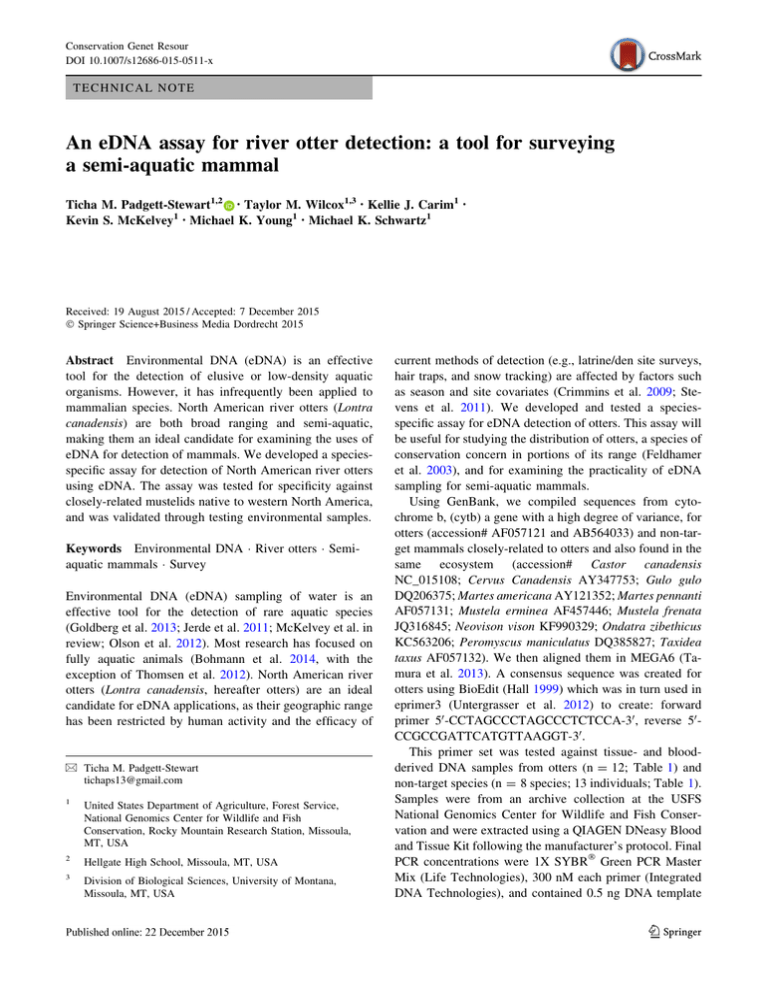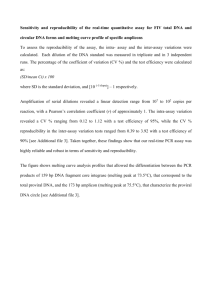An eDNA assay for river otter detection: a tool for... a semi-aquatic mammal
advertisement

Conservation Genet Resour DOI 10.1007/s12686-015-0511-x TECHNICAL NOTE An eDNA assay for river otter detection: a tool for surveying a semi-aquatic mammal Ticha M. Padgett-Stewart1,2 • Taylor M. Wilcox1,3 • Kellie J. Carim1 Kevin S. McKelvey1 • Michael K. Young1 • Michael K. Schwartz1 • Received: 19 August 2015 / Accepted: 7 December 2015 Ó Springer Science+Business Media Dordrecht 2015 Abstract Environmental DNA (eDNA) is an effective tool for the detection of elusive or low-density aquatic organisms. However, it has infrequently been applied to mammalian species. North American river otters (Lontra canadensis) are both broad ranging and semi-aquatic, making them an ideal candidate for examining the uses of eDNA for detection of mammals. We developed a speciesspecific assay for detection of North American river otters using eDNA. The assay was tested for specificity against closely-related mustelids native to western North America, and was validated through testing environmental samples. Keywords Environmental DNA River otters Semiaquatic mammals Survey Environmental DNA (eDNA) sampling of water is an effective tool for the detection of rare aquatic species (Goldberg et al. 2013; Jerde et al. 2011; McKelvey et al. in review; Olson et al. 2012). Most research has focused on fully aquatic animals (Bohmann et al. 2014, with the exception of Thomsen et al. 2012). North American river otters (Lontra canadensis, hereafter otters) are an ideal candidate for eDNA applications, as their geographic range has been restricted by human activity and the efficacy of & Ticha M. Padgett-Stewart tichaps13@gmail.com 1 United States Department of Agriculture, Forest Service, National Genomics Center for Wildlife and Fish Conservation, Rocky Mountain Research Station, Missoula, MT, USA 2 Hellgate High School, Missoula, MT, USA 3 Division of Biological Sciences, University of Montana, Missoula, MT, USA current methods of detection (e.g., latrine/den site surveys, hair traps, and snow tracking) are affected by factors such as season and site covariates (Crimmins et al. 2009; Stevens et al. 2011). We developed and tested a speciesspecific assay for eDNA detection of otters. This assay will be useful for studying the distribution of otters, a species of conservation concern in portions of its range (Feldhamer et al. 2003), and for examining the practicality of eDNA sampling for semi-aquatic mammals. Using GenBank, we compiled sequences from cytochrome b, (cytb) a gene with a high degree of variance, for otters (accession# AF057121 and AB564033) and non-target mammals closely-related to otters and also found in the same ecosystem (accession# Castor canadensis NC_015108; Cervus Canadensis AY347753; Gulo gulo DQ206375; Martes americana AY121352; Martes pennanti AF057131; Mustela erminea AF457446; Mustela frenata JQ316845; Neovison vison KF990329; Ondatra zibethicus KC563206; Peromyscus maniculatus DQ385827; Taxidea taxus AF057132). We then aligned them in MEGA6 (Tamura et al. 2013). A consensus sequence was created for otters using BioEdit (Hall 1999) which was in turn used in eprimer3 (Untergrasser et al. 2012) to create: forward primer 50 -CCTAGCCCTAGCCCTCTCCA-30 , reverse 50 CCGCCGATTCATGTTAAGGT-30 . This primer set was tested against tissue- and bloodderived DNA samples from otters (n = 12; Table 1) and non-target species (n = 8 species; 13 individuals; Table 1). Samples were from an archive collection at the USFS National Genomics Center for Wildlife and Fish Conservation and were extracted using a QIAGEN DNeasy Blood and Tissue Kit following the manufacturer’s protocol. Final PCR concentrations were 1X SYBRÒ Green PCR Master Mix (Life Technologies), 300 nM each primer (Integrated DNA Technologies), and contained 0.5 ng DNA template 123 Conservation Genet Resour Table 1 List of target and nontarget samples used for assay verification State/province Common name # Samples ID River otter Lontra canadensis 2 MT (West of Rocky Mountain Divide) River otter Lontra canadensis 3 MT (East of Rocky Mountain Divide) River otter Lontra canadensis 3 MT (Flathead) River otter Lontra canadensis 3 SD River otter Lontra canadensis 1 MT Beaver Castor canadensis 1 MT Striped skunk Mephitis mephitis 1 ID Long-tailed weasel Mustela frenata 1 MN Long-tailed weasel Mustela frenata 1 MT Ermine Mustela erminea 1 OR Mink Neovison vison 1 CA Fisher Martes pennanti 1 BC Fisher Martes pennanti 1 PA Fisher Martes pennanti 1 CA WY Marten Marten Martes americana Martes americana 1 1 ID Wolverine Gulo gulo 1 in a final volume of 20 lL. Reactions were run in triplicate on an Applied Biosystems StepOnePlusTM Real-Time PCR System (Life Technologies) following standard cycling conditions [95 °C/10 m (95 °C/15 s, 60 °C/60 s) 9 45 cycles] followed by a 65–95 °C melt curve. Samples were analyzed on a single plate which included triplicate no template control (NTC) wells. The primers successfully amplified otter samples, with a 14 cycle delay before the limited amplification of non-targets. We used Primer Express 3.0.1 software (Life Technologies) to design an internal hydrolysis probe (Taqman MGB, Life Technologies): 50 -6FAM-ACCTCGAAACAACGGG-MGBNFQ-30 . The same instrument, cycling conditions, and samples were used to test the full assay. Fifteen lL reactions consisted of 7.5 lL 2X Environmental Mastermix 2.0 (Life Technologies), 0.75 lL 20X assay (final reaction concentrations 900 nM for primers; 250 nM for probe), 4 lL template and 2.75 lL nuclease-free diH2O. Reactions were run in duplicate with two NTC wells. There was amplification of all 13 otter samples with similar efficiency (mean amplification curve cycle threshold ‘‘mean Ct’’ ranged from approximately 16–21 cycles). There was no amplification of any non-targets tested. Most importantly, mink, the most closely-related semi-aquatic species, did not amplify (Koepfli et al. 2008). We tested assay specificity in silico by conducting a BLAST search against the sequences available in Genbank. No non-target species fully complimented more than one component of the three-part assay. We tested the assay environmentally by collecting water samples (2 and 3 L) from the otter enclosure at ZooMontana (Billings, MT, USA) which contained five otters in an 123 Scientific name approx. 8500 L pool, following the protocol outlined by Carim et al. (2015). DNA was extracted in a room dedicated to environmental samples using a QIAGEN DNeasy Blood and Tissue Kit and QIAshredder using a protocol adapted from Goldberg et al. (2011). The DNA was analyzed in triplicate using the same protocol as for assay testing, including NTC samples. Otter DNA was successfully detected in all samples from the exhibit with a mean Ct of approximately 20 and 21 for the 2 and 3 L samples, respectively. In summary, the assay was effective in detecting otter DNA from tissue and environmental samples and was species-specific. This shows the assay’s use as a tool in evaluating the efficacy of species-specific eDNA surveying of otters, and further suggests its potential for other semiaquatic mammals. Future efforts should concentrate on paired testing of traditional and eDNA detection methods to field validate the assay and assess its real-world sensitivity. Finally, we note that eDNA assays are extremely sensitive and will positively amplify even a single copy of target DNA (Wilcox et al. 2013), which can prove problematic when working with tissue samples not taken or stored with the stringent standards eDNA requires. In our study, some non-target tissue samples were contaminated with otter DNA (confirmed by sequencing the non-target amplicons) and were discarded in final results. Reference sample cleanliness must be ensured when screening assays. Acknowledgments We thank ZooMontana and Mackenzie Mentel for exhibit samples. We thank Justin Gude, Neil Anderson, Jeff Copeland, Wayne Melquist, Jody Tucker, Kristy Pilgrim, and Joel Sauder for reference samples. We also thank Rob Jensen and Conservation Genet Resour Advanced Problems in Science, Hellgate high school, Missoula, MT, USA, for their support. TMW is supported by a NSF Graduate Research Fellowship (Grant No. DGE-1313190). References Bohmann K, Evans A, Gilbert MTP, Carvalho GR, Creer S, Knapp M, Douglas MY, de Bruyn M (2014) Environmental DNA for wildlife biology and biodiversity monitoring. Trends Ecol Evolut 29(6):358–367 Carim KJ, Padgett-Stewart T, Wilcox TM, Young MK, McKelvey KS, Schwartz MK (2015) Protocol for collecting eDNA samples from streams. U.S.D.A. Forest Service, National Genomics Center for Wildlife and Fish Conservation. V2.3 (July 2015). http://www.fs.fed.us/research/genomics-center/docs/edna/ednaprotocol.pdf Crimmins SM, Roberts NM, Hamilton DA, Mynsberge AR (2009) Seasonal detection rates of river otters (Lontra canadensis) using bridge-site and random-site surveys. Can J Zool 87:993–999 Feldhamer GA, Thompson BC, Chapman JA (2003) Wild mammals of North America: biology, management, and conservation. JHU Press, Baltimore, pp 708–734 Goldberg CS, Pilliod DS, Arkle RS, Waits LP (2011) Molecular detection of vertebrates in stream water: a demonstration using Rocky Mountain tailed frogs and Idaho giant salamanders. PloS one 6(7):e22746 Goldberg CS, Sepulveda A, Ray A, Baumgardt J, Waits LP (2013) Environmental DNA as a new method for early detection of New Zealand mudsnails (Potamopyrgus antipodarum). Freshw Sci 32(3):792–800 Hall TA (1999) BioEdit: a user-friendly biological sequence alignment editor and analysis program for Windows 95/98/NT. Nucl Acids Symp Ser 41:95–98 Jerde CL, Mahon AR, Chadderton WL, Lodge DM (2011) ‘‘Sightunseen’’ detection of rare aquatic species using environmental DNA. Conserv Lett 4(2):150–157 Koepfli KP, Deere KA, Slater GJ, Begg C, Begg K, Grassman L, Lucherini M, Veron G, Wayne RK (2008) Multigene phylogeny of the Mustelidae: resolving relationships, tempo and biogeographic history of a mammalian adaptive radiation. BMC Biol 6(1):10 McKelvey KS, Young MK, Knotek L, Carim KJ, Wilcox TM, Padgett TM, Schwartz MK (In review) Sampling large geographic areas for rare species using environmental DNA (eDNA): a study of bull trout occupancy in western Montana. J Fish Biol Olson ZH, Briggler JT, Williams RN (2012) An eDNA approach to detect eastern hellbenders (Cryptobranchus a. alleganiensis) using samples of water. Wildl Res 39(7):629–636 Stevens SS, Just EH, Cordes RC, Brooks RP, Serfass TL (2011) The influence of habitat quality on the detection of river otter (Lontra canadensis) latrines near bridges. Am Midl Nat 166:435–445 Tamura GS, Peterson D, Filipski A, Kumar S (2013) MEGA6: molecular evolutionary genetics analysis version 6.0. Mol Biol Evolut 30:2725–2729 Thomsen P, Kielgast JOS, Iversen LL, Wiuf C, Rasmussen M, Gilbert MTP, Willerslev E (2012) Monitoring endangered freshwater biodiversity using environmental DNA. Mol Ecol 21(11):2565–2573 Untergrasser A, Cutcutache I, Koressaar T, Ye J, Faircloth BC, Remm M, Rozen SG (2012) Primer3: new capabilities and interfaces. Nucleic Acids Res 40(15):e115 Wilcox TM, McKelvey KS, Young MK, Jane SF, Lowe WH, Whiteley AR, Schwartz MK (2013) Robust detection of rare species using environmental DNA: the importance of primer specificity. PLoS ONE 8(3):e59520 123





